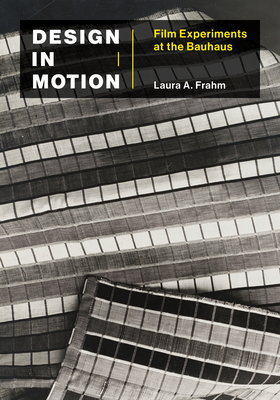Design in Motion: Film Experiments at the Bauhaus

Design in Motion: Film Experiments at the Bauhaus
The first comprehensive history in English of film at the Bauhaus, exploring practices that experimented with film as an adaptable, elastic "polymedium." With Design in Motion, Laura Frahm proposes an alternate history of the Bauhaus--one in which visual media, and film in particular, are crucial to the Bauhaus's visionary pursuit of integrating art and technology. In the first comprehensive examination in English of film at the Bauhaus, Frahm shows that experimentation with film spanned a range of Bauhaus practices, from textiles and typography to stage and exhibition design. Indeed, Bauhausler deployed film as an adaptable, elastic "polymedium," malleable in shape and form, unfolding and refracting into multiple material, aesthetic, and philosophical directions. Frahm shows how the encounter with film imbued the Bauhaus of the 1920s and early 1930s with a flexible notion of design, infusing painting with temporal concepts, sculptures with moving forms, photographs with sequential aesthetics, architectural designs with a choreography of movement. Frahm considers, among other things, student works that explored light and the transparent features of celluloid and cellophane; weaving practices that incorporate cellophane; experimental films, social documentaries, and critical reportage by Bauhaus women; and the proliferation of film strips in posters, book covers, and other typographic work. Viewing the Bauhaus's engagement with film through a media-theoretic lens, Frahm shows how film became a medium for "design in motion." Movement and process, rather than stability and fixity, become the defining characteristics of Bauhaus educational, aesthetic, and philosophical ethos.
PRP: 310.08 Lei
Acesta este Prețul Recomandat de Producător. Prețul de vânzare al produsului este afișat mai jos.
248.06Lei
248.06Lei
310.08 LeiLivrare in 2-4 saptamani
Descrierea produsului
The first comprehensive history in English of film at the Bauhaus, exploring practices that experimented with film as an adaptable, elastic "polymedium." With Design in Motion, Laura Frahm proposes an alternate history of the Bauhaus--one in which visual media, and film in particular, are crucial to the Bauhaus's visionary pursuit of integrating art and technology. In the first comprehensive examination in English of film at the Bauhaus, Frahm shows that experimentation with film spanned a range of Bauhaus practices, from textiles and typography to stage and exhibition design. Indeed, Bauhausler deployed film as an adaptable, elastic "polymedium," malleable in shape and form, unfolding and refracting into multiple material, aesthetic, and philosophical directions. Frahm shows how the encounter with film imbued the Bauhaus of the 1920s and early 1930s with a flexible notion of design, infusing painting with temporal concepts, sculptures with moving forms, photographs with sequential aesthetics, architectural designs with a choreography of movement. Frahm considers, among other things, student works that explored light and the transparent features of celluloid and cellophane; weaving practices that incorporate cellophane; experimental films, social documentaries, and critical reportage by Bauhaus women; and the proliferation of film strips in posters, book covers, and other typographic work. Viewing the Bauhaus's engagement with film through a media-theoretic lens, Frahm shows how film became a medium for "design in motion." Movement and process, rather than stability and fixity, become the defining characteristics of Bauhaus educational, aesthetic, and philosophical ethos.
Detaliile produsului









